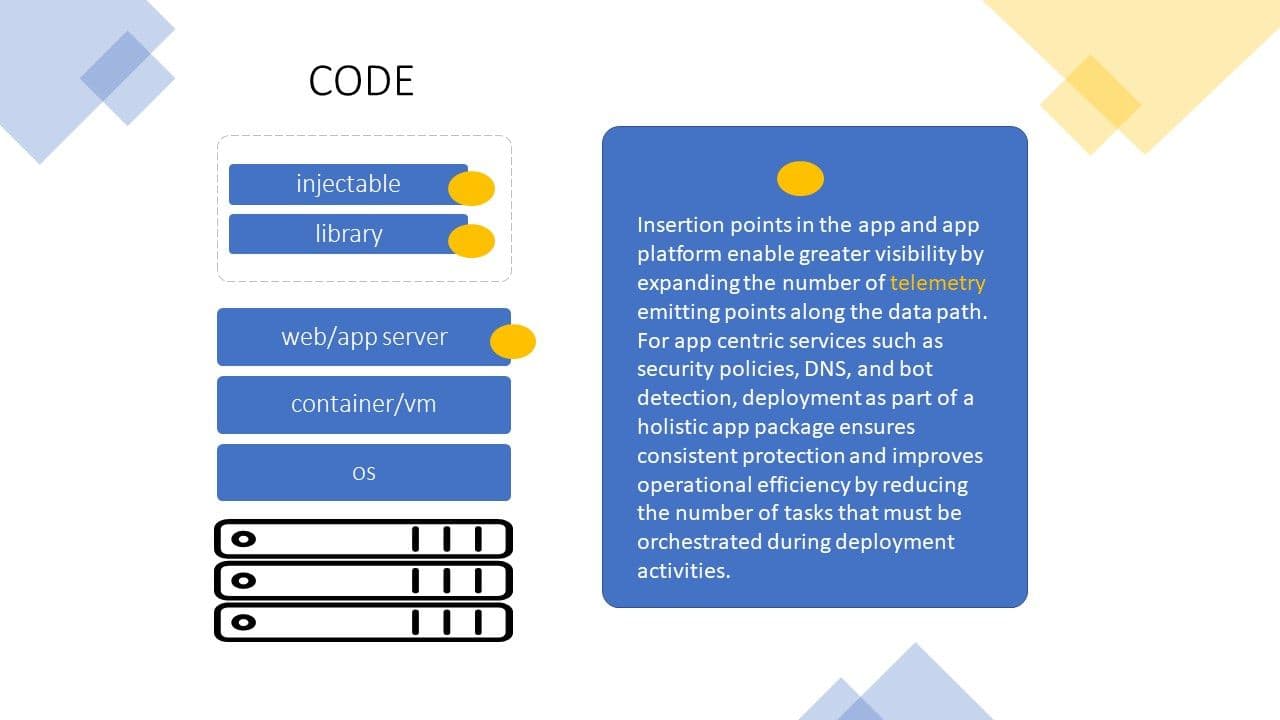In a previous post, we explored the notion of adding app services to shifting app architectures using a concept we call "insertion points." For those who haven't followed along, an insertion point is an architecturally distinct location in the code to customer data path at which it makes sense to add functionality that is often outside the purview of development or operationally more efficient.

A robust set of capabilities add or enhance the applications that represent business activities today.
Insertion points include the client, infrastructure, and the app itself. Each point has its pros and cons when it comes to balancing operational and cost efficiencies. For example, it is likely not operationally or cost-efficient to insert a network-centric DDoS app service into the client or the app. This is because neither insertion point has access to the hardware-accelerated capabilities available with an infrastructure option nor do they have the visibility necessary to make an accurate determination.
So, what we're looking for are app services that are both operationally and cost efficient at the point of insertion; in this case, we're focused on the app server (platform) itself.
The App Platform as an Insertion Point
At first, this insertion point may seem like an odd choice. App servers host and deliver apps, not app services. But if you consider the role NGINX and other app servers play today, you'll find them often playing the part of both infrastructure and server at the same time. For example, some app servers can and do act as an SSL termination point. SSL termination is an app service, often coupled with SSL offload (hardware acceleration). Web app firewall services, too, are often coupled to app servers via plug-ins.

The use of the app server as an insertion point is neither new nor foreign. In our 2020 State of Application Services research we asked about this option for deploying app services. We found that there is interest in this insertion point. About 6% of respondents would like to use a "plug-in" for app services. Another 9% would prefer "as a service," which requires a companion piece of code (injected or included) to invoke. A small number, 4%, would like to use a library to include app services. This last option is something we see frequently used to insert functionality into serverless (function as a service) applications.
In many cases, deploying an app service on an app server makes good operational sense. Because these services are often configured to serve a single app, they can be packaged and deployed by the same team. Expertise with the app server ensures greater confidence and ease of integration into ecosystems and deployment pipelines.
In some cases, it will make sense to deploy the app and app service together, on the same instance of a single app server. For example, app protection via an app-specific policy can be plugged-in and executed as a step in the processing of requests and responses. That the functionality is invoked from within the server makes sense and, if inspection is executed locally, can improve performance by eliminating extra hops and processing by services hosted outside the environment. That can make it more efficient both operational and financially, especially if you’re paying by the hour or invocation for the service.
Whether the app server is used to host a stand-alone app service or as a host to both app and app service, the app server is certainly a good insertion point for the right app services.
About the Author

Related Blog Posts

Multicloud chaos ends at the Equinix Edge with F5 Distributed Cloud CE
Simplify multicloud security with Equinix and F5 Distributed Cloud CE. Centralize your perimeter, reduce costs, and enhance performance with edge-driven WAAP.
At the Intersection of Operational Data and Generative AI
Help your organization understand the impact of generative AI (GenAI) on its operational data practices, and learn how to better align GenAI technology adoption timelines with existing budgets, practices, and cultures.
Using AI for IT Automation Security
Learn how artificial intelligence and machine learning aid in mitigating cybersecurity threats to your IT automation processes.
Most Exciting Tech Trend in 2022: IT/OT Convergence
The line between operation and digital systems continues to blur as homes and businesses increase their reliance on connected devices, accelerating the convergence of IT and OT. While this trend of integration brings excitement, it also presents its own challenges and concerns to be considered.
Adaptive Applications are Data-Driven
There's a big difference between knowing something's wrong and knowing what to do about it. Only after monitoring the right elements can we discern the health of a user experience, deriving from the analysis of those measurements the relationships and patterns that can be inferred. Ultimately, the automation that will give rise to truly adaptive applications is based on measurements and our understanding of them.
Inserting App Services into Shifting App Architectures
Application architectures have evolved several times since the early days of computing, and it is no longer optimal to rely solely on a single, known data path to insert application services. Furthermore, because many of the emerging data paths are not as suitable for a proxy-based platform, we must look to the other potential points of insertion possible to scale and secure modern applications.
